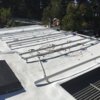My solar system install is in progress. All the panels are mounted on the roof, the inverter and other components are mounted inside my garage and the Powerwall was brought to my house today. It will be mounted today, everything connected up and tested, and if all goes well this week a SolarEdge and a Tesla Energy representative will be here to make sure everything has been done correctly. Then the county electrical inspector has to come and sign off and then it can be turned on.
Here are some details copied from the system description in the price quote:
9.69 KW SYSTEM
SolarEdge Inverter SE7600A-USS00NNM2 w/Backup & RGM for on/off-grid and
P300 optimizers (qty 34)
Solar World SW285M Modules (qty 34)
Low profile, +/- 7 degree tilt solar rack system
I will post some photos of what has been done so far.
Here are some details copied from the system description in the price quote:
9.69 KW SYSTEM
SolarEdge Inverter SE7600A-USS00NNM2 w/Backup & RGM for on/off-grid and
P300 optimizers (qty 34)
Solar World SW285M Modules (qty 34)
Low profile, +/- 7 degree tilt solar rack system
I will post some photos of what has been done so far.


















